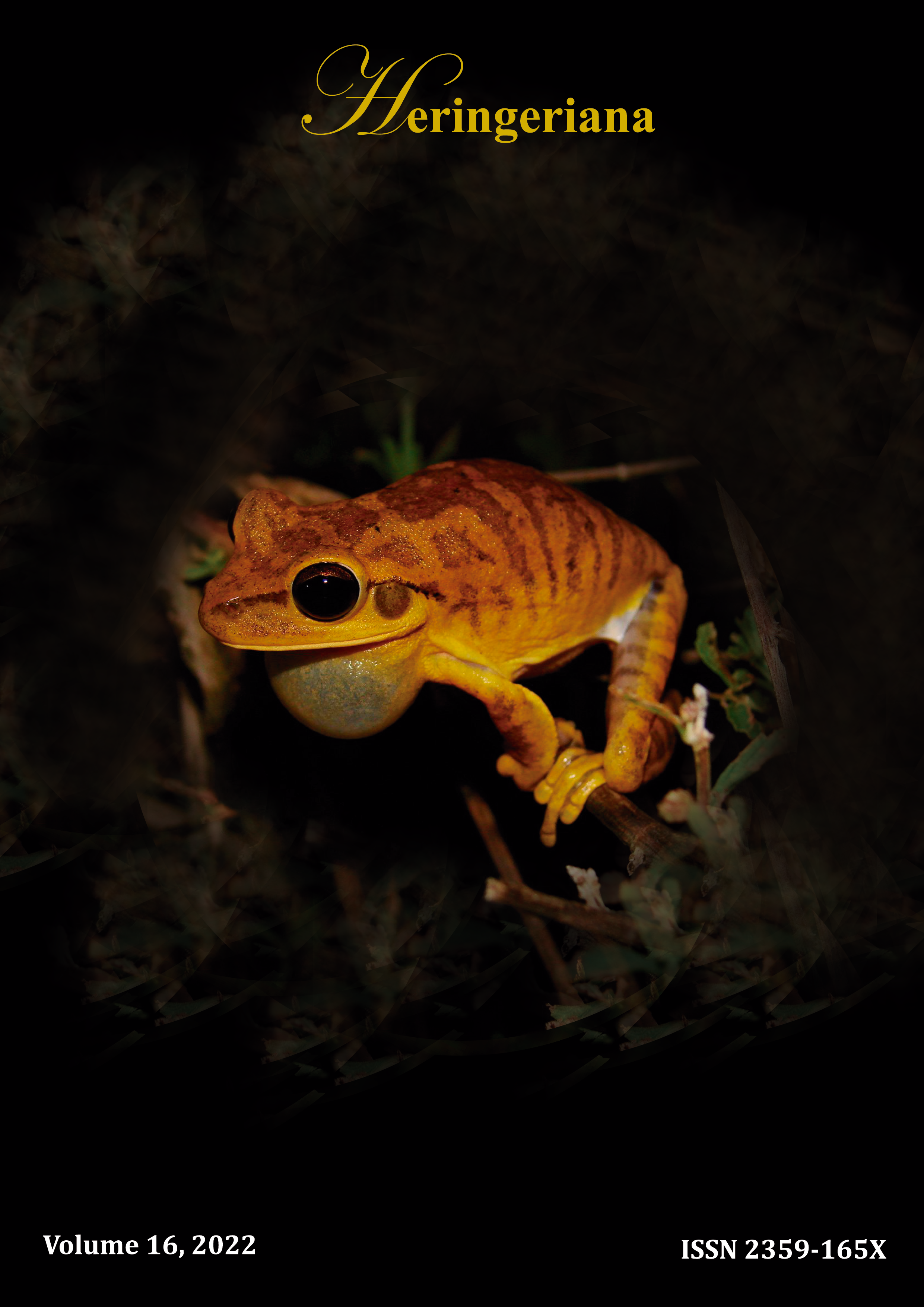Population growth, biometrics and conchological variation of Iphigenia brasiliensis (Bivalvia: Donacidae) in Baía de Todos os Santos, Northeast Brazil
DOI:
https://doi.org/10.17648/heringeriana.v16i1.917986Keywords:
edible bivalve, population biometrics, population variation, temporal variation, tariobaAbstract
Iphigenia brasiliensis is a species of edible bivalve, source of subsistence for many communities in the Bahia coast, but little commercialized in the Brazilian Northeast region. Changes in the morphological characteristics of its shells and in the ratio of the weight of its flesh to the volume of its shell, among other parameters, may reflect the quality of the environment where they live. In this study, we associated the population growth, biometry and shell variation of I. brasiliensis to environmental conditions, in an estuary of Bahia, between November 2001 and November 2002. Monthly salinity, water temperature, dissolved oxygen, pH, rainfall and organisms were sampled, submitted to biometric variables, condition factor and analysed by descriptive statistics. The results showed that the mean length of the individuals (n = 356) was 50.2 mm, with a mean total weight of 21.45 g, mean wet weight of the soft parts of 5.12 g, mean shell weight of 13.54 g and mean yield of the soft parts of 25.46%. The coefficient of determination was more than 95%. I. brasiliensis population growth was positive allometric for the total weight x size relationship, and isometric growth for the soft parts weight x size relationship. The monthly variation of the condition factor showed the highest values in July/2002, agreeing with the result of the yield of soft parts. Thus, it is observed the importance of basic research on the biology of different populations of bivalves, as a subsidy to the culture of these species and to the improvement of the exploitation process of natural banks.
References
Akberali, H.B. & Trueman, E.R. (1985) Review. Effects of environmental stress on marine bivalve molluscs. Advances in Marine Biology 5: 251-264. https://doi.org/10.1016/S0065-2881(08)60051-6
Araújo, C.M.Y. (2001) Biologia reprodutiva do berbigão Anomalocardia brasiliana (Mollusca, Bivalvia, Veneridae) na Reserva Extrativista Marinha do Pirajubaé. Tese de Doutorado, Pós-Graduação em Biociências, Universidade de São Paulo. 204 p.
Araújo, A.R.R, Silva, F.D. Santana, R.F. & Lopes, D.F.C. (2009) Gestão da pesca de Mytella charruana (D’ Orbigny, 1846) no litoral do estado de Sergipe: indicadores de sustentabilidade. Revista Brasileira de Engenharia de Pesca 4(2): 56-70. https://doi.org/10.18817/repesca.v4i2.237
Arcas, A.P., Ramos, A.O, Arrieche, D., Villalba, J. & Lodeiros, C. (2001) Producción secundaria e índice de condición en Arca zebra (Mollusca: Bivalvia) del Golfo d Cariaco, Venezuela. Revista de Biologia Tropical 49(2): 599-608.
Avendaño, M. & Le Pennec, M. (1997) Intraspecific variation in gametogenesis in two populations of the Chilean molluscan bivalve, Argopecten purpuratus (Lamarck). Aquaculture Research 28: 175-182. https://doi.org/10.1046/j.1365-2109.1997.00844.x
Belém, T.P.; Moura, R.S.T. & Henry-Silva, G.G. (2013) Distribuição e densidade do bivalve Anomalocardia brasiliana em praias do Rio Grande do Norte durante um período de pluviosidade atípica. Revista Biotemas 26(1): 109-122. https://doi.org/10.5007/2175-7925.2013v26n1p109
Beukema, J.J. & Desprez, M. (1986) Single and dual annual growing seasons in the tellinid bivalve Macoma balthica (L.). Journal of Experimental Marine Biology and Ecology 102(1): 35-45. https://doi.org/10.1016/0022-0981(86)90124-3
Borzone, C.A., Vargas, K.M., Pezzuto, P.R. & Tavares, Y.A.G. (2001) Aspectos da reprodução e dinâmica populacional de Chione pubera (Bory Saint-Vicent) (Bivalvia, Veneridae) no sul do Brasil. Revista Brasileira de Zoologia 18(2): 333-349. https://doi.org/10.1590/S0101-81752001000200003
Caballero, A. Cabrera, J. Solano, Y. (1997) Descripción del crecimiento y madurez sexual de una población de Crassostrea columbiensis (Mollusca: Bivalvia). Revista de Biologia Tropical 44(3): 335-339. http://hdl.handle.net/11056/23080
Callil, C.T. & Mansur, M.C.D. (2007) Gametogênese e dinâmica da reprodução de Anodontites trapesialis (Lamarck) (Unionoida, Mycetopodidae) do lago da Baía do Poço, planície de indundação do rio Cuiabá, Mato Grosso, Brasil. Revista Brasileira de Zoologia 24(3): 825-840. https://doi.org/10.1590/S0101-81752007000300033
Campos, E.R., Peña, J.C., Cruz, R.A. & Palacios, J.A. (1998) Crecimiento y ciclo reproductivo de Polymesoda radiata (Bivalvia: Corbiculidae) en Costa Rica. Revista de Biologia Tropical 46(3): 643-648. https://doi.org/10.15517/RBT.V46I3.20125
Carvalho, G.P., Cavalcante, P.R.S., Castro, A.C.L. & Rojas, M.O.A.I. (2000). Preliminary assessment of heavy metal levels in Mytella falcata (Bivalvia, Mytilidae) from Bacanga River Estuary, São Luís, State of Maranhão, Northeastern Brazil. Revista Brasileira de Biologia 60(1): 11-16. https://doi.org/10.1590/S0034-71082000000100003
Celino, J.J. & Queiroz, A.F.S. (2006) Fonte e grau da contaminação por hidrocarbonetos policíclicos aromáticos (HPAs) de baixa massa molecular em sedimentos da baía de Todos os Santos, Bahia. Revista Escola de Minas 59(3): 265-270. https://doi.org/10.1590/S0370-44672006000300003
Cruz, R.A. & Villalobos, C.R.R. (1993) Shell length at sexual maturity and spawning cycle of Mytella guyanensis (Bivalvia, Mytilidae) from Costa Rica. Revista de Biologia Tropical 41(1): 89-92. https://doi.org/10.15517/rbt.v41i1.23311
Denny, M.W. (2000) Limits to optimization: fluid dynamics adhesive strength and the evolution of shape in limpet shells. Journal of Experimental Biology 203: 2603-2622.
Domaneschi, O. & Lopes, S. (1989) Informativo da SBMa – Sociedade Brasileira de Malacologia 87, 88 e 93. https://doi.org/10.1242/jeb.203.17.2603
Gaspar M.B., Santos M.N., Vasconcelos P. & Monteiro C.C. (2002). Shell morphometric relationships of the most common bivalve species (Mollusca: Bivalvia) of the Algarve coast (southern Portugal). Hydrobiologia. 477: 73–80. https://doi.org/10.1023/A:1021009031717
Hatje, V., Bícego, M. C., Carvalho, G. C., & Andrade, J. B. (2009). Contaminação química. Baía de Todos os Santos. Aspectos oceanográficos. Salvador, Edufba, 245-297.
La Parra, A.M. García, O. & San J.F. (2005) Seasonal variations on the biochemical composition and lipid classes of the gonadal and storage tisúes of Crassostrea gigas (Thunberg, 1794) in relation to the gametogenic cycle. Journal of Shellfish Research 24(2): 457-467. https://doi.org/10.2983/0730-8000
Le Cren, E.D. (1951) The length-weigth relationship and seasonal cycle in gonadal weight condition in the Perch fluviatilis. Journal of Animal Ecology 20: 201-219. https://doi.org/10.2307/1540
Leonel, R.M.V. Magalhães, A.R.M. & Lunetta, J.E. (1983) Sobrevivência de Anomalocardia brasiliana (Gmelin, 1791) (Mollusca: Bivalvia), em diferentes salinidades. Boletim de Fisiologia Animal 7: 63-72.
Lessa, Guilherme C. Dominguez, J.M. Bittencourt, A.C. & Brichta, A. (2001) The tides and tidal circulation of Todos os Santos Bay, Northeast Brazil: a general characterization. Anais da Academia Brasileira de Ciências 73 (2): 245-261. https://doi.org/10.1590/S0001-37652001000200009
Levington, J. (1972) Stability and tropic structure in deposit-feeding ans suspension-feeding communities. American Naturalist 106: 472-486. https://doi.org/10.1086/282788
Lunetta, J.E. & Grotta, M. (1982) Influência dos fatores exógenos e endógenos sobre a reprodução de moluscos marinhos. Boletim de Fisiologia Animal 6: 191-204.
Marenzi, A. & Branco, J. (2005) O mexilhão Perna perna (Linnaeus) (Bivalvia, Mytilidae) em cultivo na Armação do Itapocoroy, Santa Catarina, Brasil. Revista Brasileira de Zoologia 22(2): 394-399. https://doi.org/10.1590/S0101-81752005000200013
Mora, D.A. & Alpizar, B.M. (1998) Growth of Mytella guyanensis (Bivalvia: Mytilidae) on floating rafts. Revista de Biologia Tropical 46: 21-26. https://revistas.ucr.ac.cr/index.php/rbt/article/view/29630
Morsan, E.M. & Orensanz, J.M. (2004) Age structure and growth in an unusual population of purple clam, Amiantis purpurata (Lamarck, 1818) (Bivalvia: Veneridae), from Argentine Patagonia. Journal of Shellfish Research 73-80. https://doi.org/10.1017/S002531540501129Xh
Morsan, E.M. & Kroeck, M.A. (2005) Reproductive cycle of purple clam, Amiantis purpurata (Bivalvia: Veneridae) in northern Patagonia (Argentina). Journal of the Marine Biological Association of the UK 85: 367-373. https://doi.org/10.1017/S002531540501129Xh
Mzighani, S. (2005) Fecundity and population structure of cockles, Anadara antiquata L. 1758 (Bivalvia: Arcidae) from a Sandy / Muddy Beach near Dar es Salaam, Tanzania. Western Indian Ocean Journal of Marine Science 4(1): 77-84. https://doi.org/10.4314/wiojms.v4i1.28475
Narchi, W. (1972) On the biology of Iphigenia brasiliensis Lamarck, 1818 (Bivalvia, Donacidae). Proceedings of the Malacological Society of London 40: 79-91. https://doi.org/10.1093/oxfordjournals.mollus.a065213
Oliveira, L., Lavander, H., Rodrigues, S., Brito, L.O. & Gálvez, A.O. (2013) Crescimento do berbigão, Anomalocardia brasiliana (Bivalvia: Veneridae) na praia de Mangue seco, Pernambuco, Brasil. Arquivos Ciências do Mar 46(1): 22-28. https://doi.org/10.32360/acmar.v46i1.887
Peña, J.H.C., Quesada, M.P., Hernández, M.U. & Vargas, O.S. (2001) Crecimiento y madurez sexual de una población de Saccostrea palmula (Mollusca: Bivalvia), Costa Rica. Revista de Biologia Tropical 49(3-4): 877-882. Disponível em:
http://www.scielo.sa.cr/scielo.php?script=sci_arttext&pid=S0034-77442001000300006&lng=en&nrm=iso
Reis Júnior, J.J.C., Freire, K.M.F., Rosa, L.C., Santos, A.C.G., Silva Lúcio, A., Santiago, B.S., Santos, B.V., Silva, I.S., Bispo, J.V., Rocha, L.S., Freire, M.C.S., Santos, R.T.V.S., Lima, R.C.D. & Santos, S.L. (2016) Análise morfométrica e de rendimento em carne de Mytilidae capturado no estado de Sergipe. Scientia Plena 12(12): 01-11. https://doi.org/10.14808/sci.plena.2016.120201
Resgalla Júnior, C., Brasil E.S & Salomão, L.C. (2006) Physiological rates in different classes of sizes of Perna perna (Linnaeus, 1758) submmited to experimental laboratory conditions. Brazilian Journal of. Biology 66: 325-336. https://doi.org/10.14808/sci.plena.2016.120201
Rodrigues, A.M. L., Borges-Azevedo, C.M., Costa, R.S. & Henry-Silva, G.G. (2010) Population structure of the bivalve Anomalocardia brasiliana, (Gmelin, 1791) in the semi-arid estuarine region of northeastern Brazil. Brazilian Journal of. Biology 73(4): 819-833. https://doi.org/10.1590/S1519-69842013000400019
Rodrigues, S., Lavander, H., Oliveira, L., Batista, A., Oliveira, I. & Gálvez, A.O. (2013) Distribuição e abundância relativa do berbigão, Anomalocardia brasiliana, na praia de Mangue Seco, Pernambuco, Brasil. Arquivos de Ciências do Mar 46(2): 70 – 75.
Santos, E.P. dos. (1978). Dinâmica de populações aplicada à pesca e piscicultura. São Paulo: EDUSP / HUCITEC. 129 p.
Santos, J.J.S., Terceiro, A.M., & Yauri, W.L.M. (2014). Dinâmica da População de Anomalocardia brasiliana (Mollusca, Bivalvia, Veneridae) no Estuário do Rio Paciência, no Município da Raposa, Estado do Maranhão. http://dx.doi.org/10.11137/2014_1_61_69
Santos, L.L. (2019) Avaliação da ocorrência de compostos organoclorados em organismos marinhos da Baía de Todos os Santos, Bahia, Brasil. Dissertação de mestrado, Programa de pós-graduação em geoquímica: petróleo e meio ambiente – POSPETRO. Universidade Federal da Bahia.
Silva, P.P., Peso-Aguiar, M.C. & Ribeiro, G. (2010) Estudo preliminar do ciclo reprodutivo da população de Iphigenia brasiliana (Lamarck, 1818) (Bivalvia, Donacidae) na Baía de Guarapuá, Cairu, Bahia. Candombá – Revista Virtual 6(2): 61-73. Disponível em: http://www.repositorio.ufc.br/handle/riufc/26189
Silva, P.P., Peso-Aguiar, M.C. & Ribeiro, G. (2012) Ciclo gametogênico e comportamento reprodutivo de Iphigenia brasiliana (Mollusca, Bivalvia, Donacidae) no estuário do rio Subaé, Baía de Todos os Santos, Bahia, Brasil. Iheringia, Série Zoologia 102(4): 359-369. https://doi.org/10.1590/S0073-47212012005000011
Silva, P.P., Peso-Aguiar, M.C. & Paz, J.R.L. da. (2016) Biometria e proporção sexual de Iphigenia brasiliana (Lamarck, 1818) (Bivalvia, Donacidae) da Baía de Guarapuá, Cairu, BA. Arquivos de Ciências do Mar 49(2): 7-14. https://doi.org/10.32360/acmar.v49i2.6551
Suárez, M.P., Alvarez, C., Molist, P. & San Juan, F. (2005) Particular aspects of gonadal cycle and seasonal distribution of gametogenic stages of Mytilus galloprovincialis cultured in the estuary of vigo. Journal of Shellfish Research 24(2): 531-540. https://doi.org/10.2983/0730-8000
Tirado, C. & Salas, C. (1999) Reproduction of Donax venustus Poili 1795, Donax semistriatus Poli 1795 and intermediate morphotypes (Bivalvia: Donacidae) in the littoral of Málaga (Southern Spain). Marine Ecology 20(2): 111-130. https://doi.org/10.1046/j.1439-0485.1999.00068.x
Vazzoler, A.E.A. (1982) Manual de métodos para estudos biológicos de populações de peixes: reprodução e crescimento. Brasília: CNPq, Programa Nacional de Zoologia. 106 p.
Vilanova, M.F.V. & Fonteles-Filho, A.A. (1989) Análise da biometria e do fator de condição da ostra-do-mangue, Crassostrea rhizophorae (Guilding, 1828) (Mollusca, Bivalvia), no estuário do rio Ceará, Ceará, Brasil. Ciência e Cultura 41(11): 1117-1124.
Wullschleger, E.B. & Jokela, J. (2002) Morphological plasticity and divergence in life-history traits between two closely related freshwater snails: Lymnaea ovata and Lymnaea peregra. Journal of Molluscan Studies 68: 1-5. https://doi.org/10.1093/mollus/68.1.1
Downloads
Published
How to Cite
Issue
Section
License
Copyright (c) 2022 Patrícia Petitinga da Silva, Joicelene Regina Lima da Paz, Daiana de Jesus do Rosário, Marlene Campos Peso-Aguiar

This work is licensed under a Creative Commons Attribution 4.0 International License.
By submitting, the authors declare that they have not submitted the work to another journal and agree to have their article published under a Creative Commons Attribution 4.0 International BY License (CC BY 4.0), which means that authors retain ownership of the copyright but anyone can use the published content provided the original authors and source are cited. The scientific, orthographic and grammatical content is the full responsibility of the authors.








